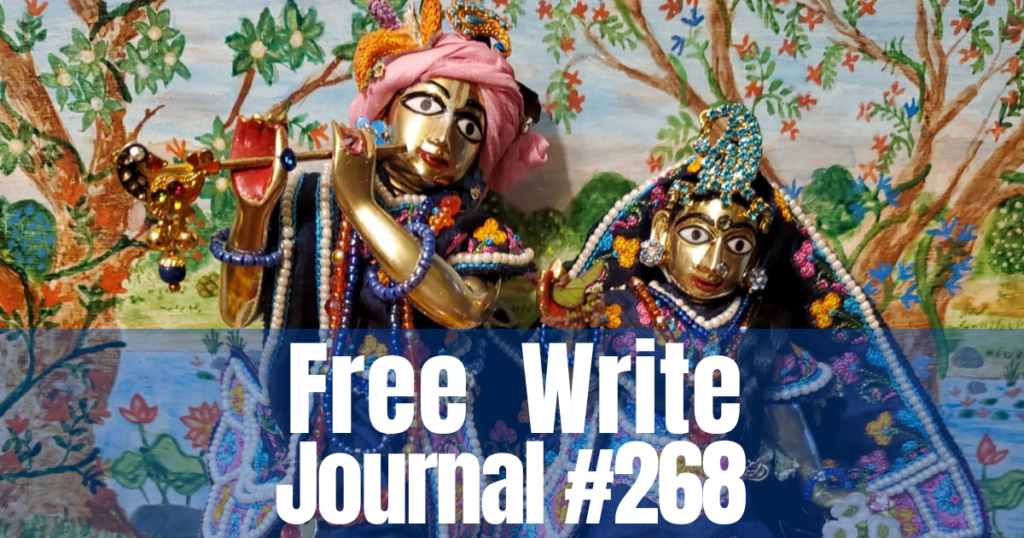
Hari Hari! . . .
There’s not much to report this week. Two new meds from the neurologist haven’t adjusted Satsvarupa Maharaja’s migraines and other physical symptoms from the Parkinson’s yet—these things take time. Maharaja did extra writing, extra chanting, and got extra headaches. There’s no dramas, and that’s a good thing.
Bvd
The “News Items” section of Free Write Journal has been temporarily suspended while Guru Maharaja recuperates.
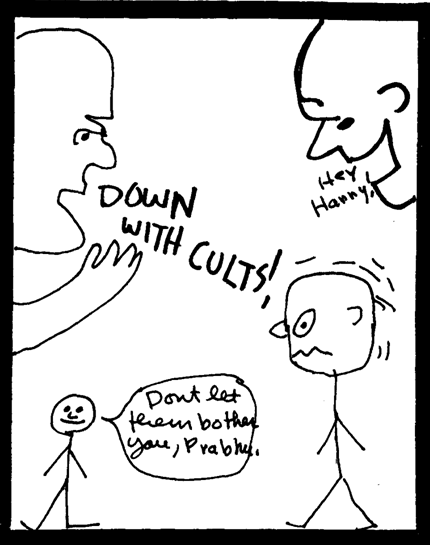
A sensational “true crime” book has been published with documented and yet fictionalized accounts of ISKCON’s criminal and bizarre activities of the last ten years. At the same time, ISKCON faces losses in anti-cult court cases, based on the charges that devotees use psychological brainwashing to entrap people against their will.
With this in mind, one devotee wrote me, “I am honestly feeling a little depressed and dispirited on seeing that this movement is not being accepted by the masses, and not only that but they are directly attacking us in so many different ways. We may lose the court case here, and then I don’t know what we’ll do. If we lose, how can we preach? . . . When will all the nonsense stop and when will we see the golden era of Lord Caitanya shine through? Will we actually become the prominent religious movement in the world, or will we always have to be struggling just to keep ourselves separated from the ‘cults?’ I wish it could be like it is in India where not everyone is a devotee, but at least we are accepted as a bona-fide religion.”
I know what I should reply to him. But I too tend to become dispirited. So we have to keep our spirits up. And there is much solid evidence to reassure us.
Prabhupada said we could expect to be defamed. He said the Krsna consciousness movement would pass through three phases. First we would be disregarded as a trifle, then the demons would take us more seriously and we would go through a period of persecution. The final phase would be acceptance, and the world would turn to the devotees for serious direction.
When we say, “The demons are attacking us,” we also have to admit that ISKCON has spawned some of its own infamy. For those mistakes, we are facing reactions. But charges like “brainwashing” are absurd attacks by anti-religionists and neo-enlightenists who think that all religious experience is in the realm of superstition.
If in our lifetime, Krsna consciousness remains a less-than-minority in the U.S.A., we should not lament. Religions have often been mistreated. Consider the birth of Christianity. Christ himself was crucified, and his sincere followers considered it a mark of their sincerity that they would be rejected and abused by the world. From Jesus’s Sermon on the Mount: “Happy are you when people insult you and persecute you and tell all kinds of evil against you because you are my followers. Be happy and glad, for a great reward is kept for you in heaven.”
Lord Caitanya’s sankirtana movement also went through persecution even in the holy land of Bharata-varsa, when the Kazi of Navadvipa tried to stop the harinama. Srila Prabhupada writes, “We must remember that such incidents took place in the past, five hundred years ago, and the fact that they are still going on indicates that our sankirtana movement is really authorized. For if sankirtana were an insignificant material affair, demons would not object to it.”
Prabhupada also told us not to be afraid of bad press. At least they’re chanting the Hare Krsna mantra even when they say, “The Krsna sect should be stopped.” And neither can the sankirtana movement be stopped, provided devotees remain sincere. If we lose temples, we can still gather and chant in the streets and distribute books, and that will do more than anything else to create favorable influence for Krsna consciousness.
I can repeat these reassuring words, yet I also worry. But that is just what the enemies of Krsna consciousness want, that we should worry and be dispirited. So let us not play into their hands.
Before becoming a devotee, while on an LSD trip, I began reading the Mentor edition of the Upanisads and became totally bewildered. I could not distinguish between the material circumstances of my room and the transcendental realm described by the book. One thing led to another, and somehow or other I fell out of the window and broke both my heels in a four-story fall. I spent the next six weeks in leg casts in my parents’ home. Since I could not walk, I read a lot.
I asked my mother for her Bible. I started reading—systematically, from the beginning—all the books of the Old Testament. It was very hard to understand, “Book of This,” “Book of That,” and I did not have any commentaries. But I continued faithfully reading the Old and New Testaments. My mother was pleased to see me reading, like the time when I was a kid and sang the Christmas carols that she had liked.
I also mailed away for a bunch of Eastern books from Mentor Paperbacks. I had the Upanisads and the Tao Te Ching, and now I got Bhagavad-gita, Teachings of the Compassionate Buddha and The Teachings of Confucius. My mother was suspicious of the East.
“You don’t really believe in that, do you?” she asked. “No, I don’t really believe it. But I am interested in it.”
Reading scriptures on one’s own presents serious obstacles. The Gita-mahatmya states, “One should read Bhagavad-gita very scrutinizingly with the help of a person who is a devotee of Sri Krsna, and try to understand it without personally motivated interpretations.” Similar advice is given in the Mahabharata: “Simply by studying the Vedas, which are variegated, one cannot come to the right path by which religious principles are understood” (Mahabharata, Vana-parva, quoted in Cc. Madhya 17.186).
Problems of independent study include: (1) The scriptures of the world seem to contradict one another; (2) They are voluminous, and one does not have time to go through all of them; (3) They are very grave and not open to most people’s understanding. . . .
Those who are expert and devoted to the life of prayer (such as the early Christian monks whose words are recorded in the Philokalia), warn that it is not possible to undertake a serious life of prayer without guidance of spiritual masters. Srila Prabhupada states that just as one cannot become a recognized lawyer or doctor merely by reading books, so a devotee is recognized only when he studies with a bona fide spiritual master. I thought I knew better because of my direct perception of Evil and “the blue.” But I hardly guessed how limited my realizations actually were. We may think that we have seen or experienced a great deal of spiritual life, but it is actually just a tiny glimpse, and even that has been influenced by hallucination. The reality of super-sensory phenomena is fully documented in Vedic literature. One does not have to imagine it or discover it by drugs. Interplanetary travel, the demigods, the secrets of yoga, the all-pervading light, and the Kingdom of God—these were all beyond my dreams, and yet they are all perceivable phenomena. But one cannot enter the spiritual realm unless one hears about it from authorized literature, and accepts the disciplines of a student studying under a master.
While I was at Brooklyn college, I had been disappointed when Zen author Allen Watts, spoke at our college and personally told me that enlightened states could be achieved by psychedelic drugs. Yet here I was, giving credence to insights gained on an LSD trip. I had criticized Watts to my friends, saying, “How could someone attain enlightenment without undergoing discipline and study and practice?” But now “it” had happened to me, and I thought I knew better.
Nevertheless, it was auspicious that I spent the whole summer reading scriptures, as if in preparation for a religious career. I told my mother that I did not really believe in Eastern religion. Neither did I really believe in the Bible. But I was “interested.” That initial interest, according to Rupa Gosvami, is known as sraddha, curiosity to hear the truth. It is the first step on the path of bhakti-yoga. The step after that is not one that you can undertake alone. You have to meet a spiritual master. As the Vedas state, “The solid truth of religious principles is hidden in the heart of an unadulterated self-realized person” (Mahaharata, Vana-parva, quoted in Cc. Madhya 17.186). But where was I going to find a spiritual master, and how could I recognize him?
Chota asked himself why he was coming to see this turtle since he was not a Krsna conscious devotee. It was all right, he told himself. He wanted to talk with a genuine solitary to get some questions answered, just as devotees sometimes consulted doctors or lawyers. He could use it in devotional service, and if the turtle said anything against Vaisnava principles, Chota would reject it.
From the shore, Chota studied the surface of the pond until he noticed a certain slimy rock that looked like the back of a turtle.
“Turtle! O Turtle!” he called, but the rock didn’t respond. A field mouse ambled over to Chota and looked him up and down. “Looking for the hermit turtle, eh?”
“Yes, can you help me?”
“It’s not so easy,” said the field mouse, brushing bits of underbrush from his shaggy coat. “He doesn’t just come up and talk to anyone. He’s very particular. They say he is over 130 years old. He’s meditating, ya know.”
This mouse is so ignorant, thought Chota, that he doesn’t know I am perhaps the most famous spiritual mouse in the world and that I have just been worshiped by 300 mice at my birthday party. But Chota kept this to himself.
“Turtle!” Chota called out loud. “My name is Chota dasa, and I have come to respectfully ask you a few questions. I’m interested in practicing solitude. I’m a student of bhakti-yoga. We read the Bhagavad-gita As It Is. I have heard that you are a great solitary. Also, in the Bhagavad-gita the tortoise is mentioned honorably several times, as you may know.” Chota felt somewhat silly because no one was there, but then the rock on the pond moved slightly, and Chota was sure that it was the turtle.
“Yes,” Chota called out, “the karmi is compared to the yogi: ‘One who is able to withdraw his senses from sense objects, as the turtle draws his limbs within the shell, is firmly fixed in perfect consciousness.’”
At these words the turtle lifted his head—it was a slimy head covered with algae, resembling a yogi’s matted locks—and looked noncommittally in Chota’s direction.
Chota continued, “There’s also a verse in Vedic literature that states, ‘By meditating only, the turtle maintains his offspring and so do I, O Padmaja.” I really do wish you would come over and let me speak to you for a few minutes, dear turtle.”
With a swift movement, the turtle submerged and reappeared perched on a rock in the water just a few feet from Chota. The turtle was three times Chota’s size. Its massive shell was covered with slime and chipped in a few places. Its legs were scarred and it emanated a rotten odor. But Chota sensed that he was face to face with a genuine hermit.
“What do you want to know?” asked the turtle. “Anyway, there’s nothing that I can put into words.”
“I’ve become interested in solitude,” said Chota. “For us devotees that means chanting Hare Krsna and reading the Vedic scriptures. I heard that you have been practicing solitude for a long time. So—how did you decide you wanted to live alone and practice meditation?”
The turtle blinked. “You have to be called to it,” he said. Chota waited for him to say more, but he was silent. Chota sensed that this was going to be a short interview, and so he had better be as direct as possible.
“How do you know if you’re called?”
“Some know it from their earliest youth,” the turtle said. “They find their way by instinct to the place where they will be alone. But some reach solitude the hard way, through suffering and disillusion.”
“I don’t understand,” said Chota. “How do you get invited, or as you say, called?”
“Look,” the turtle said, “if you can’t firmly decide for yourself, then you aren’t called. Solitude can choose you, but you don’t belong to her until you accept. Do you understand?”
Chota decided to keep asking questions and to think it over later.
A neophyte’s devotional service becomes interrupted when he becomes diseased. Vigorous service requires good health. We have to chant our rounds attentively and that takes physical strength as well as mental and spiritual stamina.
Often devotees experience trouble in their relationships with others when they become ill. Other devotees take over our services or don’t understand our illness. All of these things can lead to disappointment.
“In disappointment, Sanatana Gosvami considered, ‘I am of a low caste, and my body is useless for devotional service.’”
Sanatana Gosvami had two reasons to lament: he had oozing sores all over his body, and he considered himself low and fallen because of his low caste. Of course, Sanatana was born a high-caste brahmana, but because he had taken service in the Muslim government and associated intimately with Muslims, he considered that he had lost his high caste and was now a lowborn man.
Then, “When I go to Jagannatha Puri, I shall not be able to see Lord Jagannatha, nor shall I always be able to see Sri Caitanya Mahaprabhu.”
Is it possible to be too humble? No, we should think of ourselves as lower than the straw on the street. We are tiny spirit souls, and that is the only accurate analysis of ourselves. That does not mean, however, that our bodies are useless for devotional service. Therefore, it is possible to exaggerate our low condition and to engage in what the psychologists call low self-esteem. Low self-esteem is not healthy. We can judge by the result whether we are experiencing humility or low self-esteem. Humility brings enlivenment and dependence on Krsna; low self-esteem makes us feel so unqualified that we no longer perform service and we exclude ourselves from the society of devotees. Low self-esteem is a misconception about our actual position; it is a material estimation.
For example, Sanatana Gosvami said that he will not be able to see Lord Jagannatha because he could not enter the temple. Although most ISKCON devotees cannot go into the Jagannatha temple at Puri, Prabhupada told us not to be disappointed. Sanatana says, “I have heard that the residential quarters of Sri Caitanya Mahaprabhu are near the temple of Jagannatha. But I shall not have the power to go near the temple.” Not only did he have to avoid the temple, but he could not go near the temple in order to visit Lord Caitanya because “the servants of Lord Jagannatha generally move about tending to their duties, but if they touch me I shall be an offender.” All his feelings are compounded by the fact that he has an obnoxious disease.
There is a bridge situated at the entrance of Jagannatha Puri called Atharanala which has eighteen arches. Athara means “eighteen” (Cc. Madhya-lila 5.147, purport)
This bridge is mentioned several times in Caitanya-caritamrta. It is symbolic of the emotion of arriving or departing from Jagannath Puri. After Lord Caitanya took sannyasa, when He first went to Jagannath Puri, His approach to the bridge signaled His increased ecstasy. He saw the temple cakra, offered His obeisances and began to dance in the ecstasy of love of God:
Sri Caitanya Mahaprabhu laughed. cried, danced and made many ecstatic vibrations and sounds. Although the temple was only six miles away. to Him the distance seemed thousands of miles. Thus walking and walking, the Lord eventually arrived at the place known as Atharanala. Arriving there. He expressed His external consciousness, speaking to Sri Nityananda Prabhu. (Cc. Madhya-lila 5.146-7)
It was at this point that Lord Caitanya asked Nityananda Prabhu to return His sannyasa staff and the Lord learned that Nityananda Prabhu had broken it. From the bridge, Lord Caitanya then went on alone to see Lord Jagannatha.
While Lord Caitanya resided in Puri, He also used to send His men to greet incoming devotees at the bridge:
Everyone in the party was very anxious at heart to see Caitanya Mahaprabhu; therefore, they hastily went on to Jagannath Puri. When they all arrived at a bridge called Atharanala, Sri Caitanya Mahaprabhu, hearing the news of their arrival, sent two garlands with Govinda. Govinda offered the two garlands to Advaita Acarya and Nityananda Prabhu, and They both became very happy. Indeed, they began chanting the holy name of Krsna on that very spot, and, dancing and dancing, both Advaita Acarya and Nityananda Prabhu reached Jagannath Puri. (Cc. Madhya-lila 16.37-40)
Jagannath Puri is overflowing with places and incidents connected with Lord Caitanya. Almost everywhere you go there is some place where the Lord enjoyed sublime pastimes in separation from Radha and Krsna or in chanting Hare Krsna with His devotees. The day we visited the bridge I happened to have a stomachache and was dragging myself around in bodily consciousness, but even so, I could appreciate how Jagannath Puri is special. I knew my low consciousness was simply a sign of the conditioned state.
This sacred tank was the scene of another joyous pastime of Lord Caitanya with His devotees, as recorded in Madhya-lila, Chapter Fourteen.
It was at Indradyumna Sarovara that Lord Caitanya engaged in water sports with His intimate associates. His pure devotees held water duels with one another. Lord Nityananda dueled with Advaita Acarya, and when Advaita Acarya was defeated, He spoke bad names against Lord Nityananda. When Sarvabhauma Bhattacarya fought in the water against Ramananda Raya, they both lost their gravity and became like children. Lord Caitanya smiled to see their exuberance but asked them to desist. Then Lord Caitanya entered the water and asked Advaita Acarya to take the role of Ananta Sesa. The Lord lay on the bed of Ananta Sesa and floated in the water. Who can understand the inconceivable pastimes of Lord Caitanya at Indradyumna Sarovara? The tank of Indradyuma is similar in size to Narendra Sarovara, but the water seems fresher, with no sign of stagnation. On the left, as you enter, there is a temple to King Indradyumna. On the right, there is an old temple with the Deities of Radha and Krsna. Residents frequent the lake, bathing and diving in, and the shore is littered with used nim toothsticks. The day we went, our mood was somewhat interrupted by an insistent young man who led us to the altars of each temple and made us recite prayers out loud after him and bow down at his verbal command. We thanked him for his assistance, made a donation, but then observed darsana on our own, as we have been shown by Srila Prabhupada.
Dear Friends,
I’m writing this letter to you while leaning back on a rock, my rubber rain gear keeping me dry even in this cold, wet bog land in Ireland. It’s late October, and I’m in the hills of this poor, rural country. Nobody around for miles but the sheep. The ferns and other bushes are now brown, but the grass in Ireland is always green. It’s 7:30 in the morning, and the sky has lost most of its grayness.
I have chanted sixteen rounds so far today, and I’m sitting here, wondering what it is I would like to say. I always have to think about whether or not to communicate when I’m out here, because thinking of speaking always creates a tension between wanting to communicate and the desire to enter a deeper communion with Krsna alone. Although I feel this tension constantly, I know myself well enough to say that no matter how alone I am, sooner or later I will want to retrieve something from my experience and share it with others. Because that’s what Prabhupada wanted of me—of all of us. We are preachers. Therefore, if I share the benefits of solitude for a contemplative Krsna conscious life, I am reconciled as a preacher.
As I write, I see three sheep walking down the hill into the valley below. I can’t hear them, but I see their innocent white bodies moving down a path into another pasture. It’s somehow a beautiful sight. Krsna’s creation bears a resemblance to Himself in a sense, and to our original home in Goloka Vrndavana. Rosy clouds remind us of Goloka, and birds here make us think of birds there.
The only thing missing in this world is the revelation of Krsna and the transformation that comes about in everything when He is directly present. If it were Krsna walking down that path barefoot, playing His flute, with boys running on all sides and calves and cows gamboling, I wouldn’t be sitting here leaning against a stone. I would run to join Him, to serve Him. If I could see Him, it would mean I was completely purified and not some lone philosopher. Everything in this world speaks to us about the necessity to become fully Krsna conscious. This world lives in separation from Krsna.
They said we were too young to be steady
in Krsna consciousness—fanatics they considered us
and that may have been true
but they were wrong about the other part—that we
wouldn’t be steady and that we were too
young.
Oh, we were foolish and too young
to know better or what to expect
from ourselves our
Movement
our ideals
those tall orders we received
and worshiped from our beautiful
brown-skinned mentor from India.
We told him we would serve him forever,
and perhaps we still will—we promised, after all,
to give up everything for him
and what’s ours was his, what’s his, ours.
We would sound off the Krsna conscious cannon
in millions of cities—whatever
he wanted
us
to do.
Our youth was our asset. He promised us that we’d attain
the love supreme.
Of course, our youth prevented us from knowing about
Black Panthers and panes of glass broken in our faces
and the fear. We didn’t know
ISKCON would lose its potency
when it seemed so potential.
We’re older and wiser now, still
blessed by guru, going steady
with a master who loved us then and
loves us more now
that we have faltered and gone wrong
but not left him.
Hare Krsna. How am I today? What am I doing? How shall I serve this day?
The best thing is to absorb oneself in chanting and hearing the Names, forms, lila and qualities of Radha-Madhava. That I will do, in japa and hearing a tape and reading with my friends.
Writing poems, etc., comes when there’s an excess of feeling—I just have to put it into writing. But I may also approach the page out of a need, out of a feeling of emptiness. Begin, “Why don’t I feel anything? Why do I feel so purposeless today?” And then pick up a trail of thought as it occurs to you.
Write whatever comes, and don’t end a session thinking this was not a good one. They are all good, and they all are “not good”—in the sense that I remain a tiny beggar with Krsna’s mercy on me. Gurudeva has the good qualities, the attachment to Krsna, and He can grant it to me. So thinking, “This session was particularly good” is still a kind of passion for results.
Or it may be that I sense Krsna’s mercy in a particular session. Okay, that’s okay. I’m just trying to encourage myself through a session like this one, where it seems “nothing is happening.” To keep going at such times is important. Therefore something is “happening” when I insist on my practice, even through the desert. Haribol, haribol, we are chanting for the four directions, to the sun and the moon. We feel a chill, but what can be done? We have sold ourselves to Mukunda’s service in writing, at least for this hour.
Then when I go to japa, it’s even more pronounced that I need to keep trying even when I don’t get desired results. I surrender in that way. Again and again, with each bead and each word in each mantra, I fail to be attentive and devoted. Yet again and again I chant. This is my devotion, and I love it, strange as it sounds. St. John of the Cross and other practitioners of prayer have credited this persistence through arid times as a high order of surrender. There’s something to be said for it, even more than for times when we are tasting nectar. There’s no other choice for a neophyte except to persist or give up. He takes joy and satisfaction in persisting, even though there are no external signs of that joy. If someone suggests to him, “Why don’t you give up chanting? Don’t do it if it’s just a guilt trip or a duty,” he’ll find the devotee shocked and disgusted at the suggestion. “No! I will never give up japa (or writing). Even if it takes me many lifetimes to realize the nectar … I am not doing this to taste spiritual sense gratification, but because I am the eternal servant of the servant of the Lord and it is my constitutional nature to chant His names.”
Thank You Lord for this realization. That double-banded attitude of prayerfulness in japa is good—Thank You, and please help me.
Hare Krsna Hare Krsna, Krsna Krsna Hare Hare
Hare Rama Hare Rama, Rama Rama Hare Hare.
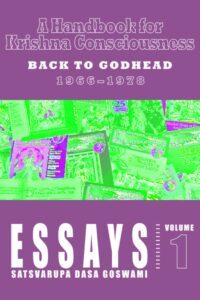
This collection of Satsvarūpa dāsa Goswami’s writings is comprised of essays that were originally published in Back to Godhead magazine between 1966 and 1978, and compiled in 1979 by Gita Nagari Press as the volume A Handbook for Kṛṣṇa Consciousness.
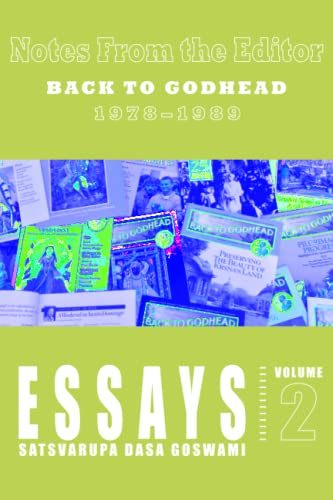
This second volume of Satsvarūpa dāsa Goswami’s Back to Godhead essays encompasses the last 11 years of his 20-year tenure as Editor-in-Chief of Back to Godhead magazine. The essays in this book consist mostly of SDG’s ‘Notes from the Editor’ column, which was typically featured towards the end of each issue starting in 1978 and running until Mahārāja retired from his duties as editor in 1989.
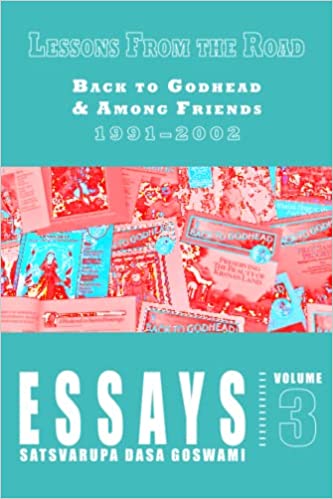
This collection of Satsvarupa dasa Goswami’s writings is comprised of essays that were originally published in Back to Godhead magazine between 1991 and 2002, picking up where Volume 2 leaves off. The volume is supplemented by essays about devotional service from issues of Satsvarupa dasa Goswami’s magazine, Among Friends, published in the 1990s.
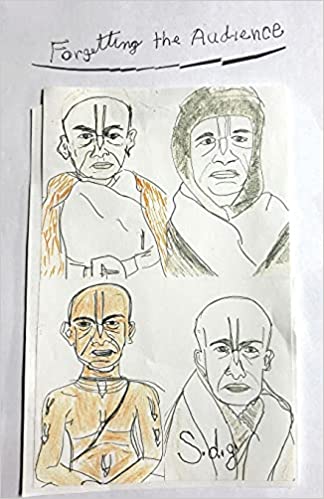
Writing Sessions at Castlegregory, Ireland, 1993Start slowly, start fastly, offer your obeisances to your spiritual master, His Divine Grace A.C. Bhaktivedanta Swami Prabhupada. You just drew his picture with your pencils. He appears carved out of wood…
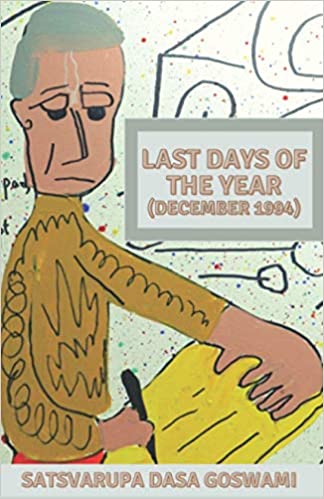 Last Days of the Year
Last Days of the YearI found I had hit a stride in my search for theme in writing, then began to feel the structure limiting me. After all, I had given myself precious time to write full-time; I wanted to enter the experience as fully as possible. For me, this means free-writing—writing sessions with no predetermined shape, theme, or topic…
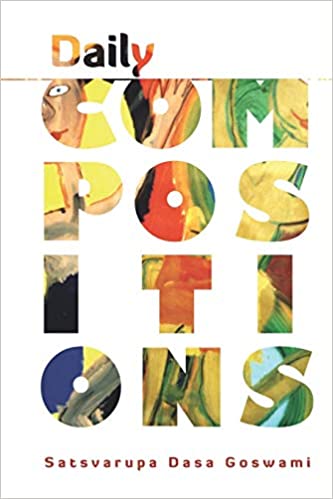 aily Compositions
aily CompositionsThis volume is comprised of three parts: prose meditations, free-writes, and poems each of which will be discussed in turn. As an introduction, a brief essay by the author, On Genre, has also been included to provide contextual coordinates for the writing which follows…
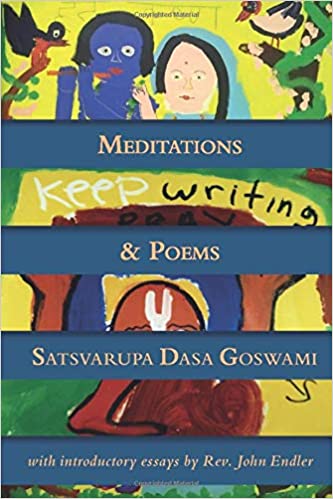 Meditations & Poems
Meditations & PoemsA comprehensive retrospective of poetic achievement and prose meditations, using a new trajectory described as “free-writing”. This volume will offer to readers an experience of the creativity versatility which is a hallmark of this author’s writing.
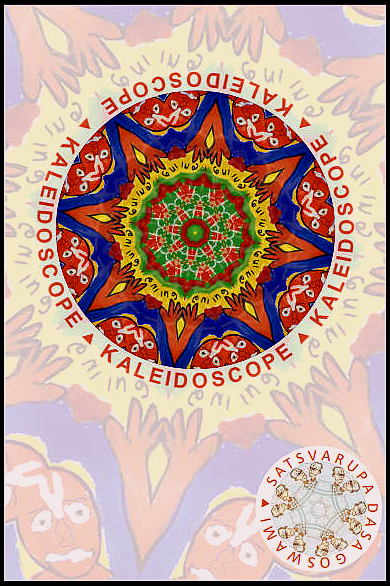 Kaleidoscope
KaleidoscopeStream of consciousness poetry that moves with the shifting shapes and colors characteristic of a kaleidoscope itself around the themes of authenticity. This is a book will transport you to the far reaches of the author’s heart and soul in daring ways and will move you to experience your own inner kaleidoscope.
Read more »
 A narrative poem. challenging and profound, about the journey of an itinerant monk who pursues new means of self-Seeking New Land
A narrative poem. challenging and profound, about the journey of an itinerant monk who pursues new means of self-Seeking New Landexpression.The reader is invited to discover his or her own spiritual pilgrimage within these pages as the author pushes every literary boundary to boldly create something wholly new and inspiring.